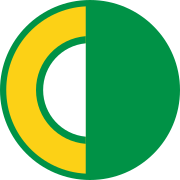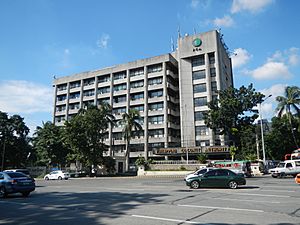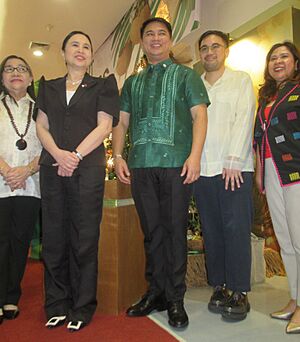Philippine Coconut Authority facts for kids
| Pangasiwaan sa Niyog ng Pilipinas | |
 |
|
 PHILCOA headquarters, Quezon City |
|
| Agency overview | |
|---|---|
| Formed | June 30, 1973 |
| Headquarters | Elliptical Road, Vasra, Diliman, Quezon City 14°39′14″N 121°03′06″E / 14.65385°N 121.05174°E |
| Agency executive |
|
| Parent agency | Department of Agriculture |
The Philippine Coconut Authority (PCA), also known as PHILCOA, is a special agency of the Philippine government. It works under the Department of Agriculture. The PCA's main job is to help the coconut and other palm oil industries grow strong and become successful around the world. This means making sure the industry is united, competitive, and works well.
Contents
How the PCA Started
The Philippine Coconut Authority was created on June 30, 1973. This happened because of a special order called Presidential Decree 232. The PCA took over the jobs and responsibilities of three older groups. These groups were the Coconut Coordinating Council (CCC), the Philippine Coconut Administration (PHILCOA), and the Philippine Coconut Research Institute (PHILCORIN).
Today, the PCA is the only government agency focused on helping the coconut industry. Its goal is to make the industry as strong as it can be. This includes making it competitive globally and very efficient.
Early Efforts for Coconuts
Back in 1940, a group called the National Coconut Corporation (NACOCO) was formed. Its purpose was to help the coconut industry grow and develop. Later, in 1954, NACOCO changed its name to the Philippine Coconut Administration (PHILCOA). It kept the same important tasks.
About ten years later, PHILCOA expanded its work. It became the Philippine Coconut Research Institute (PHILCORIN). This new agency was created to watch, check, and do research on coconuts.
In 1971, during a time of growth, the Coconut Coordinating Council (CCC) was created. It replaced PHILCORIN. The CCC was in charge of overseeing and checking government programs. These programs aimed to make the country self-sufficient in coconuts.
Why a New Agency Was Needed
The older agencies, like CCC, PHILCOA, and PHILCORIN, had a problem. They didn't always work together with a single clear goal. Their plans didn't fully focus on helping the coconut industry as a whole. More importantly, they didn't always put the coconut farmers first.
Because of this, the Philippine government decided a new agency was needed. This new agency would fix these issues. So, the Philippine Coconut Authority was created on June 30, 1973. It took on all the powers, jobs, people, and property of the old CCC, PHILCOA, and PHILCORIN.
On July 14, 1976, the PCA became an independent public corporation. This meant it reported directly to the Office of the President. A special order, Presidential Decree No. 961, made this happen. This order was the first time all the laws about developing the coconut and palm oil industry were put together.
The rules for the PCA were updated on June 11, 1978. This happened with Presidential Decree No. 1468, also known as the "Revised Coconut Industry Code." This code became the official guide for the PCA as a public corporation.
PCA's Place in Government
On January 30, 1987, the Philippine Coconut Authority officially became part of the Department of Agriculture (DA). This change was made to help coordinate and monitor all the plans and programs in farming. This move was confirmed in the Administrative Code of 1987.
In May 2014, the PCA was moved to the Office of the President. This was done by President Benigno Aquino III. Other agencies like the National Food Authority were also moved. Then, in July 2016, President Rodrigo Duterte moved the PCA to the Office of the Cabinet Secretary. Finally, in September 2018, the PCA was moved back to the Department of Agriculture. This shows how important the PCA's role is in the government.
Helping After Earthquakes
In 2014, a report showed how the Philippine Coconut Authority helped people. They worked with the Bureau of Fisheries and Agriculture. They created a "Food-For-Work" program. This program helped people who were affected by the 2013 Bohol earthquake. It gave them ways to earn a living and rebuild their lives.


